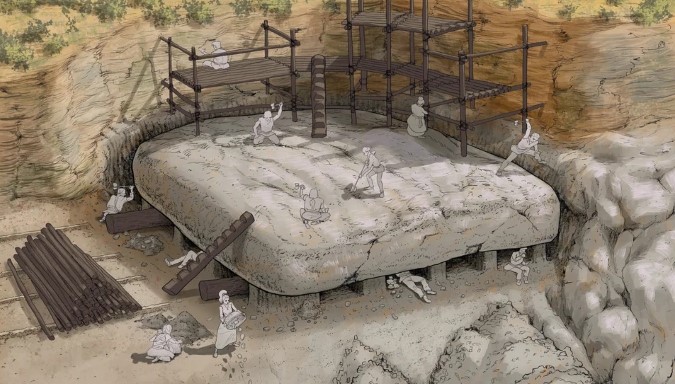An enormous burial mound in southern Spain has been hailed as one of the most impressive structures of the Neolithic period following a new examination of its humongous features. Known as the Menga dolmen, the incredible monument is thought to have been built around 5,700 years ago and contains the skeletons of several hundred ancient individuals.
Weighing around 150 tons, Menga’s capstone is the second largest stone ever used in a Neolithic dolmen, and the overall structure is described by the researchers as “the most colossal stone monument built in its time in Europe.” After analyzing the dolmen’s oversized building blocks, the study authors discovered that the ancient builders also chose to work with soft stone that required a huge amount of technical skill and logistical organization to erect.
Using a range of petrographic and stratigraphic analysis techniques, the researchers learned that the Menga stones are “mostly calcarenites, a poorly cemented detrital sedimentary rock comparable to those known as ‘soft stones’ in modern civil engineering.” Such stones are particularly tricky to transport without damaging them, which means whoever built Menga must have planned the project meticulously.
“Working with these large and fragile stones must have involved a massive labor investment not only in stone working, but also in wood-working and rope-making,” write the study authors. “Large amounts of wood must have been used to build the scaffolding used in the quarrying process and to prepare the roads on which the massive stones were transported.”

Artistic representation of quarrying activities for the extraction the capstone.
Located on a hilltop, the tomb was carefully oriented to provide “three major locational advantages”. For instance, the dolmen’s position perfectly aligns with the nearby mountain known as “Lover’s Rock” and the sunrise, “which produces a complex pattern of light and shadow inside the chamber.”
On top of this, the site’s location slightly below the quarry that provided the raw materials enabled the ancient builders to transport the massive rocks in a constant downhill trajectory. Finally, the substrate on the hilltop is considerably more stable than the surrounding soft clay soils, thus providing a firmer and more secure base for the dolmen.
Despite these advantages, the porous nature of the stones used to construct the tomb would ordinarily have left them vulnerable to water damage. To overcome this problem, Menga’s designers insulated the largest stones with large mounds – or tumuli – made of “alternating layers of carefully interlocking flat sandstones and pressed ground.”
Taking into account all of these innovations, the researchers gush that “the construction of Menga embodies a unique accomplishment representing the state-of-the-art in megalithic engineering in prehistoric Iberia and possibly in Europe.”
The study is published in the journal Scientific Reports.
Source Link: Colossal Prehistoric Tomb Was “Greatest Engineering Feat” Of The Stone Age